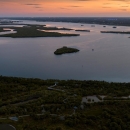Laws and Regulations
The National Wildlife Refuge System is managed by the U.S. Fish and Wildlife Service, an agency within the U.S. Department of the Interior. The U.S. Fish and Wildlife Service is the primary federal entity responsible for conserving and enhancing the nation’s fish and wildlife populations and their habitats. Although our agency shares this responsibility with other federal, state, tribal, local and private entities, we have specific trust resource responsibilities for migratory birds, threatened and endangered species, certain anadromous fish, certain marine mammals, coral reef ecosystems, wetlands, and other special aquatic habitats. We also has similar trust responsibilities for the lands and waters we administer to support the conservation and enhancement of all fish and wildlife and their associated habitats.
National wildlife refuges and wetland management districts are special places where wildlife comes first. All activities allowed on refuges and districts must be evaluated to make sure each activity will not conflict with the reason it was founded. The National Wildlife Refuge System has special regulations about what you can do during your visit. You can find these regulations in the 50 Code of Federal Regulations - Subchapter C.


